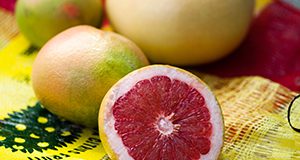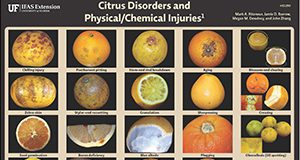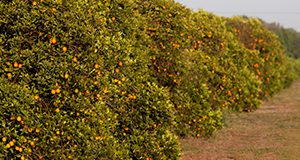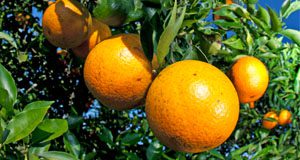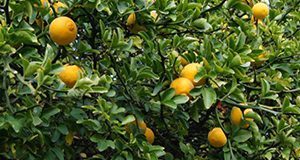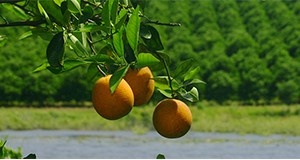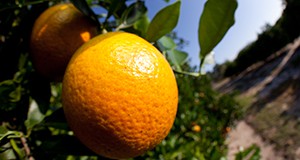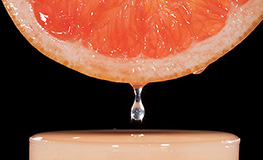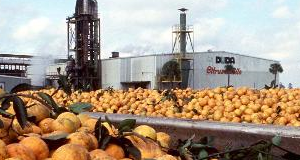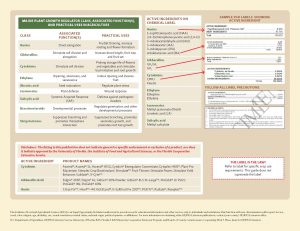This 4-page article written by Ariel Singerman and published by the Food and Resource Economics Department presents the cost of production per acre for growing fresh grapefruit in the Indian River region during 2015/2016, based on a survey of growers conducted at the Indian River Citrus League production committee meeting in mid-July 2016. The cost estimates do not represent any individual operation; rather, their purpose is to serve as a benchmark for the industry. Typical users of these estimates include growers, consultants, property appraisers, and researchers.
http://edis.ifas.ufl.edu/fe1011
Category: Citrus
Citrus Fruit Blemishes and Decay Caused by Fungi and Bacteria
This new one-page citrus identification fact sheet illustrates different blemishes from fungi and bacteria that affect citrus. Written by Mark A. Ritenour, Jamie D. Burrow, Megan M. Dewdney, and John Zhang and published by the Horticultural Sciences Department.
http://edis.ifas.ufl.edu/hs1291
Managing the Health and Productivity of HLB-Affected Groves
After years of extensive research from across the world, we still do not have a cure for HLB; however, we have learned a lot about this disease, the plant’s response to the disease, and the disease vector. Based on scientific and observational information gathered in the last decade, a number of tools and strategies are currently available for growers to maintain the health and productivity of HLB-affected trees. This four-page fact sheet will shed light on these currently available horticultural inputs and practices that can be implemented immediately by growers to maintain and improve citrus tree health.Written by Tripti Vashisth and published by the Horticultural Sciences Department.
http://edis.ifas.ufl.edu/hs1288
Citrus Disorders and Physical/Chemical Injuries
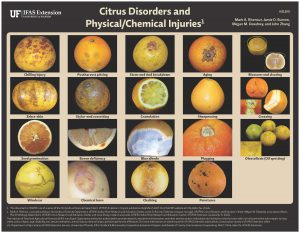
This new one-page Citrus Identification fact sheet illustrates different disorders and injuries that affect citrus. Written by Mark A. Ritenour, Jamie D. Burrow, Megan M. Dewdney, and John Zhang and published by the Horticultural Sciences Department.
http://edis.ifas.ufl.edu/hs1290
Citrus Nutrition Management Practices
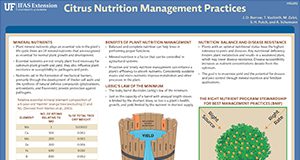
A new two-page fact sheet has been published by the Horticultural Sciences Department and the UF/IFAS Citrus Research and Education Center about citrus nutrition management practices. It was written by J.D. Burrow, T. Vashisth, M. Zekri, S.H. Futch, and A. Schumann.
http://edis.ifas.ufl.edu/hs1292
Citrus Flavonoid Effects on Obesity
The increased prevalence of obesity in recent decades has sparked tremendous concern worldwide. A type of phytochemical, called flavanoids, has been shown in clinical trials to provide significan benefits to overall health because of their antioxidant abilities. Flavanoids are especially abundant in citrus species. This two-page fact sheets describes the health benefits of citrus flavanoids. Written by Yu Wang and Laura Reuss and published by the Food Science and Human Nutrition Department.
http://edis.ifas.ufl.edu/fs285
Evolution of Citrus Disease Management Programs and Their Economic Implications: The Case of Florida’s Citrus Industry
New exotic diseases (citrus canker, HLB, and citrus black spot) have sharply increased the real cost of production of citrus in Florida. Growers have been applying different management strategies, and more effective treatments are being researched. The costs and benefits of these alternatives will need to be quantified to establish their economic feasibility. This 5-page fact sheet written by Ariel Singerman and Marina Burani-Arouca and published by the Food and Resource Economics Department focuses on the costs of managing exotic citrus diseases as they become endemic or established within a citrus industry, with Florida used as an example. The steep increase in the real cost of production of citrus in Florida from 2003/04 to 2014/15 provides evidence that managing endemic exotic diseases is very costly for growers, even without taking into account the effect those diseases have on yields. Therefore, governmental policies focused on preventing the introduction of additional exotic diseases would be highly beneficial for citrus growers and the Florida citrus industry as a whole.
edis.ifas.ufl.edu/fe915
Cost of Production for Processed Oranges Grown in Southwest Florida, 2015/16
This 4-page fact sheet written by Ariel Singerman and published by the Department of Food and Resource Economics presents the cost of production per acre for processed oranges in southwest Florida during 2015/16. Thirteen growers participated in the survey and provided annual, per-acre costs by program for a “typical” irrigated, mature grove (10+ years old), including resets. The number of acres managed by their combined operations accounts for approximately 41,000 acres, of an estimated 257,298 acres devoted to oranges in the area, so the sample represents 16% of the acreage devoted to oranges in that region. Typical users of the estimates in this publication include growers, consultants, property appraisers, and researchers.
http://edis.ifas.ufl.edu/fe1007
Cost of Production for Processed Oranges Grown in Central Florida (Ridge), 2015/16
This 4-page fact sheet written by Ariel Singerman and published by the Department of Food and Resource Economics presents the cost of production per acre for processed oranges in central Florida during 2015/16. Five growers participated in the survey and provided annual, per-acre costs by program for a “typical” irrigated, mature grove (10+ years old), including resets. The number of acres managed by their combined operations accounts for approximately 29,000 acres, of an estimated 137,154 acres devoted to oranges in the area, so the sample represents 21% of the acreage devoted to oranges in that region. Typical users of the estimates in this publication include growers, consultants, property appraisers, and researchers.
http://edis.ifas.ufl.edu/fe1006
An Overview of the Grapefruit Market in South Korea
According to the Foreign Agricultural Service of the United States Department of Agriculture, worldwide consumption of fresh grapefruit in 2014/15 increased from 4.2 million to 5.2 million metric tons. China, which is the largest producer of grapefruit, was largely responsible for the increase. In South Korea, however, the state of Florida in the United States has traditionally dominated the grapefruit market. The South Korean grapefruit market has been increasing in recent years and is expected to keep growing. The industry in Florida now faces fierce competition from other suppliers with lower import prices and different harvest seasons. This 5-page fact sheet written by Yan Heng, Hyeyoung Kim, and Lisa House and published by the Food and Resource Economics Department aims to provide an overview of the grapefruit market in South Korea and evaluate the potential of this market for Florida fresh grapefruit producers.
http://edis.ifas.ufl.edu/fe1003
Florida Citrus Activity Book
The Florida Citrus Activity Book is a basic introduction to Florida citrus trees, diseases, and pests. This 20-page booklet is for elementary students. Written by J.D. Burrow, M.M. Dewdney, M.E. Rogers, and T. Vashisth and published by the Plant Pathology Department.
http://edis.ifas.ufl.edu/pp331
Harvesting Charges for Florida Citrus: Picking, Roadsiding, and Hauling, 2015/16
A survey of Florida citrus harvesters was conducted in July 2016 to collect data and estimate the harvesting charges to Florida citrus growers during the 2015/16 season. This 5-page fact sheet written by Ariel Singermam, Marina Burani-Arouca, and Stephen H. Futch and published by the UF Department of Food and Resource Economics presents the results of the survey, summarizing the harvesting charges for citrus during the 2015/16 season and documenting the changes in harvesting costs as the impact of HLB increases across the state. The estimates presented provide the basis for computing on-tree prices from delivered-in prices, thus allowing the computation of the change in citrus growers’ economic returns as the industry adapts to remain profitable.
http://edis.ifas.ufl.edu/fe1005
Planting and Annual Cultural Maintenance Costs for Reset-Replacement Trees in a Florida Citrus Grove in 2016
Replacement of diseased, unproductive or dead trees is an important part of the cultural program for citrus groves. This five-page fact sheet uses prices and productivity rates collected through a telephone survey in May 2016 to analyze the different preferred management and reset practices. Written by Marina Burani-Arouca, Stephen H. Futch, and Ariel Singerman and published by the Food and Resource Economics Department.
http://edis.ifas.ufl.edu/fe995
Profitability of Citrus Tree Greenhouse Production Systems in Florida
Nurseries are a vital part of the citrus industry in Florida, providing growers with trees for replanting and expanding citrus groves. As part of the response to citrus greening and canker disease in the industry, nursery-aimed regulations were set in place to try to guarantee the production of trees “free of virus or other graft transmittable diseases” in plant nurseries. The new regulations resulted in an important shift for producers from traditional open field groves to greenhouses. This 4-page fact sheet describes an experiment performed at the UF/IFAS Mid-Florida REC in Apopka to test the profitability of different inputs in citrus-producing greenhouse nurseries and provides recommendations that will be useful for the whole citrus-tree-producing sector. Written by Hayk Khachatryan and Alicia Rihn and published by the Food and Resource Economics Department.
http://edis.ifas.ufl.edu/fe999
Quick Reference Guide: for Plant Growth Regulators (PGR) in Florida Citrus Production
A new two-page fact sheet explains Plant Growth Regulators (PGRS) and their application and use in Florida citrus production. Written by T. Vashisth and J.D. Burrow and published by the Horticultural Sciences Department.
http://edis.ifas.ufl.edu/hs1284
Huanglongbing (HLB; citrus greening) and Nutrient Deficiency Identification

Huanglongbing (HLB) is a bacterial disease that is spread by an insect, the Asian citrus psyllid. This two-page fact sheet, which is best viewed as a PDF, http://edis.ifas.ufl.edu/pdffiles/PP/PP32800.pdf, explains how to tell the difference between HLB symptoms and symptoms from nutrient deficiencies. Written by T. Vashisth, M.M. Dewdney, and J.D. Burrow and published by the Plant Pathology Department.
http://edis.ifas.ufl.edu/pp328
Citrus Nutrition UF/IFAS Grower Trials (Pamphlet)
Interested in learning more about citrus nutrition grower trials? This two-page pamphlet provides information on the goals, objectives, benefits, and considerations of the trials as well as specific information about trials being held from 2015-2017. The pamphlet also contains a sign up form for the trials. Written by Tripti Vashisth and Jamie D. Burrow and published by the Horticultural Sciences Department.
http://edis.ifas.ufl.edu/hs1283
Frequently Asked Questions About Huanglongbing (HLB; citrus greening) for Homeowners
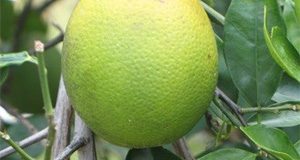
Huanglongbing (HLB), also known as citrus greening, is a serious bacterial disease that affects citrus in Florida. Florida residents enjoy growing citrus for a variety of reasons, but growing citrus in today’s disease climate is not an easy task. This seven-page document is designed to help Master Gardeners and homeowners answer commonly asked questions about HLB. Written by Brooke L. Moffis, Jamie D. Burrow, Megan M. Dewdney, and Michael E. Rogers and published by the Plant Pathology Department.
http://edis.ifas.ufl.edu/pp326
Huanglongbing (HLB; citrus greening) Leaf and Fruit Symptom Identification
Huanglongbing (HLB), commonly known as citrus greening, is a bacterial disease that affects all citrus varieties. This two-page fact sheet describes the leaf and fruit symptoms of HLB. Written by Jamie D. Burrow and Megan M. Dewdney and published by the Department of Plant Pathology.
http://edis.ifas.ufl.edu/pp327
2014/15 Average Packing Charges for Florida Fresh Citrus
A survey of Florida fresh citrus packers was conducted in April 2015 to collect data on their packing charges during the 2014/15 season. A total of sixteen packinghouses participated in the survey, seven from the Interior region and nine from the Indian River region. The average of their responses was computed to obtain the estimates presented in this 4-page fact sheet was written by Ariel Singerman, and published by the UF Department of Food and Resource Economics, March 2016.
http://edis.ifas.ufl.edu/fe989
